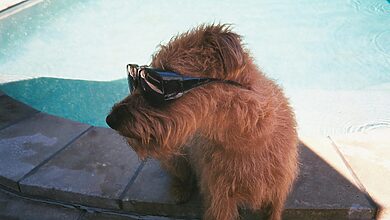Counterconditioning & Desensitization: Overcoming Fear & Phobias

Our pets bring immense joy and companionship into our lives. However, they can also face their own internal battles with fear and phobias, much like humans. Whether it’s thunderstorms, fireworks, car rides, or separation anxiety, these issues can disrupt their happiness and well-being. In this comprehensive guide, we will delve deeply into two powerful techniques—counterconditioning and desensitization—to help your pet overcome their fears and phobias. We’ll explore practical techniques, share heartwarming success stories, and provide valuable tips to help your beloved furry friend become a more confident and contented companion.
Section 1: Understanding Pet Fear and Phobias
The Nature of Pet Fear and Phobias
Fear is a primal emotion, and our pets are not immune to it. To help your pet overcome their fears and phobias, it’s essential to understand the fundamental differences between everyday fear and phobias:
Everyday Fear: Everyday fear is a normal and healthy response to a perceived threat or danger. For instance, if your dog startles at a sudden loud noise, it’s a typical fear response, and it serves as a survival instinct.
Phobias: Phobias, in contrast, are intense, irrational fears that can significantly disrupt a pet’s life. These fears are often triggered by specific stimuli, such as thunderstorms or strangers. Phobias can cause your pet to experience extreme distress and anxiety, making it essential to address them.
Recognizing the signs of a phobia in your pet, such as trembling, panting, or attempting to hide, is the first step towards helping them.
The Impact of Fear and Phobias on Pets
Fear and phobias can have a profound effect on our pets’ well-being, both physically and behaviorally:
Physical Effects: Fear can manifest physically through increased heart rate, trembling, and excessive panting. This stress response can put a significant strain on your pet’s body, affecting their overall health and longevity.
Behavioral Effects: Behavioral changes, such as aggression, withdrawal, or destructive behavior, are common in pets with phobias. These changes can disrupt the bond between you and your furry companion, making it crucial to address their fears promptly.
Understanding the profound impact of fear and phobias on your pet’s life is essential for providing empathetic support and effective treatment.
Section 2: Counterconditioning for Pets
What is Counterconditioning?
Counterconditioning is a powerful technique that can help your pet replace a negative emotional response with a positive one. Understanding the process is key to successfully addressing your pet’s fears and phobias:
The Process: Counterconditioning involves pairing the fearful stimulus with something your pet loves and enjoys. For instance, if your dog fears thunderstorms, you might offer treats, engage in play, or provide comforting attention during a storm. The goal is to create a positive association with the previously feared stimulus.
Gradual Exposure: The cornerstone of successful counterconditioning is gradual exposure to the feared stimulus. Start with a level of exposure that your pet can tolerate without becoming overly anxious. Over time, increase the intensity or duration of exposure while continuing to provide positive reinforcement.
Counterconditioning Success Stories
Success stories are powerful examples of how counterconditioning can transform a pet’s life and help them conquer their fears:
Overcoming Thunderstorm Anxiety: Meet Max, a dog who used to tremble and hide during thunderstorms. Max’s owner, through consistent counterconditioning with treats and engaging play during storms, helped Max associate thunderstorms with positive experiences. As a result, Max’s anxiety during storms has significantly reduced, and he can now weather the tempest with much more confidence.
Beating Fireworks Fear: Lucy, a cat, used to cower and hide when fireworks lit up the sky. Lucy’s owner applied counterconditioning by offering treats, interactive toys, and soothing attention during fireworks displays. Over time, Lucy has learned to remain calm and unfazed during celebrations, thanks to these positive associations.
These success stories illustrate the transformative power of counterconditioning in helping pets overcome their fears and live happier lives.
Section 3: Desensitization for Pets
What is Desensitization?
Desensitization is another valuable technique that gradually exposes your pet to their fear trigger in a controlled and systematic manner. Understanding the principles behind desensitization is essential:
Step-by-Step Exposure: Desensitization involves exposing your pet to the fear-inducing stimulus at a level they can tolerate without becoming overly anxious. You start with a minimal level of exposure and gradually increase either the intensity or duration of the exposure over time.
Building Confidence: The core goal of desensitization is to build your pet’s confidence and reduce their fear response. By helping them acclimate to the previously dreaded situation or stimulus, you empower them to face their fears more comfortably.
Desensitization for Car Travel Anxiety
Car travel anxiety is a common issue for pets, but desensitization can make a significant difference in their comfort during car rides:
Start Small: Begin by having your pet sit in the stationary car while offering treats and positive reinforcement. Gradually progress to short drives, slowly increasing the distance and duration. This incremental approach helps your pet adjust at their own pace.
Positive Associations: The ultimate goal of desensitization for car travel anxiety is for your pet to associate car rides with positive experiences. Over time, they may even eagerly hop into the car, looking forward to the adventures that await.
Desensitization can transform your pet from a nervous traveler into a relaxed co-pilot, making journeys together a more enjoyable experience.
Section 4: Combining Counterconditioning and Desensitization
The Power of Combining Techniques
While counterconditioning and desensitization are formidable tools on their own, combining them can yield even more remarkable results:
Counterconditioning During Desensitization: During desensitization sessions, use counterconditioning techniques to create positive associations. For instance, during gradual exposure to fireworks sounds, offer treats and comforting play. This combination reinforces the positive emotions associated with the feared stimulus.
Reinforcing Success: The synergy between these techniques reinforces your pet’s progress and helps them overcome their fears more effectively. By using both counterconditioning and desensitization, you provide your pet with a well-rounded approach to conquering their fears.
Conclusion
Fear and phobias should not cast a shadow over your pet’s life. With patience, understanding, and the powerful tools of counterconditioning and desensitization, you can help your furry friend conquer their fears and lead a happier, more confident life. Every small step towards overcoming a phobia is a giant leap towards a brighter future for your beloved pet.







